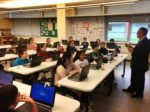Parents, teachers, and administrators agree that significant changes should be made to the United State’s educational system to better prepare today’s students for the future. A recent study, sponsored by Microsoft in collaboration with McKinsey and Company’s Education Practice, highlights three major changes researchers say should be made immediately if the class of 2030 is to succeed. The study drew from surveys and focus groups involving 2,000 students and 2,000 teachers and included input from 70 global thought leaders as well as an analysis of 150 pieces of existing research.
Members of the class of 2030 are already in kindergarten, so school curricula must be adapted for them now. While the report focuses on what schools and teachers should do, parents are also an integral part of preparing their young children for future success.
1. Social and Emotional Learning (SEL)
A child can excel in academics but not be successful in the workforce, or life, if they do not have social and emotional skills that allow them to work with others, feel empathy, manage their emotions, and create and sustain positive relationships. Employers report that many graduates are not ready for the workforce because they lack these skills. While some schools have begun focusing on SEL, many teachers say they do not address these needs.
Parents can help prepare their children for future success by working on their social and emotional abilities, as well as their academic skills. High test scores and GPA alone do not predict success. Children who can play and cooperate with others their age are at an advantage.
2. Personalized Learning
Most educators have long believed that personalized learning is the most effective learning method. However, it’s an approach that requires a lower student–teacher ratio than is present in today’s classrooms. Hiring more teachers would result in smaller class sizes and allow for individualized teaching. Additional technology can also help by allowing teachers to manage routine learning via computer and spend more time one-to-one with students.
Many parents already have a good idea of how their child learns. Some students like to sit and read from a young age. Others need to be active and hands-on. And others enjoy technology, even at age five. Parents should feel free to experiment with various learning strategies at home to determine what works best.
3. Existing and Emerging Technologies
Not so long ago, students could only interact freely with others in their classroom or their school. Now, they can learn from others all around the world. Internet connections and collaborations are already widely used, but new technology is being developed daily. Artificial intelligence and virtual reality both offer exciting new possibilities for both classroom and home learning, as does mixed reality, a combination of the physical and digital world (e.g., holograms).
Parents can help prepare their students by providing as much technological exposure as possible. If they feel inadequate to help their children in this area, they can benefit from taking online classes themselves to keep up with new developments. It’s all too easy for parents to fall behind their ten-year-old child in technical expertise.
The Microsoft report offers helpful suggestions for making today’s students successful, and it should find support among the education community. Time, money, and a new focus are needed to act on these findings.
In the meantime, parents can aid their students by teaching them social and emotional learning skills and introducing them to new learning technologies. A different school environment in which teachers and parents have more freedom to focus on these three educational priorities could also be helpful. Online learning via a K12-powered school offers students an individualized education where they can gain the skills, knowledge, and confidence they need to succeed. Technology is an essential part of all K12-powered virtual schools, and as your child’s Learning Coach, you’ll have more opportunities to teach them necessary SEL skills.




































